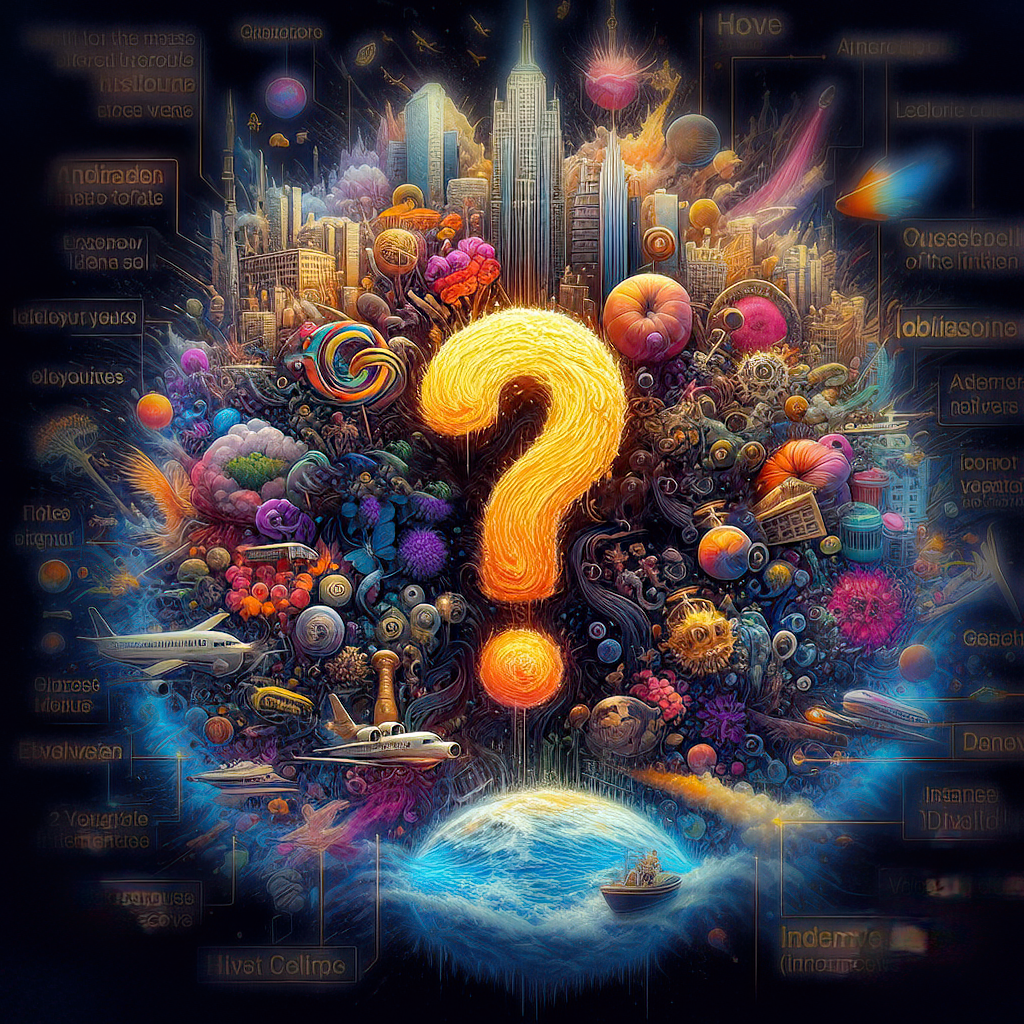
par Bill Tiepelman
Intégration de la préfiguration visuelle et textuelle
L'art de créer des prophéties : intégrer la préfiguration visuelle et textuelle Les prophéties sont un outil narratif classique, qui ajoute de l'intrigue, de la tension et de la profondeur à votre récit. Qu'il s'agisse d'énigmes énigmatiques, d'inscriptions anciennes ou de prédictions murmurées, les prophéties peuvent servir de boussole narrative, laissant entrevoir l'avenir tout en façonnant les décisions de vos personnages. Mais élaborer une prophétie convaincante ne se résume pas à une formulation astucieuse : c'est l'occasion de mélanger texte et éléments visuels pour une expérience narrative plus riche. Dans ce guide, nous découvrirons comment créer des prophéties captivantes et les intégrer à votre histoire en utilisant à la fois des préfigurations écrites et visuelles. Plongeons dans l'art de créer des prophéties qui captivent votre public et le laissent impatient de découvrir la vérité. Pourquoi les prophéties sont importantes dans la narration Les prophéties sont bien plus que de simples éléments de l'intrigue : ce sont des ancres thématiques qui ajoutent des niveaux de sens à votre histoire. Voici pourquoi elles ont un tel impact : Créer de l’anticipation : les prophéties créent un sentiment d’inévitabilité, gardant les lecteurs accrochés alors qu’ils tentent de comprendre ce qui va se passer. Formez les personnages : la façon dont vos personnages interprètent et réagissent à une prophétie peut révéler leurs valeurs, leurs peurs et leurs motivations. Préfiguration : les prophéties vous permettent de semer des indices sur des événements futurs, rendant le résultat plus satisfaisant lorsque tout se met en place. Ajoutez du mystique : la nature cryptique des prophéties confère un air de mystère et de magie à votre monde. Mais pour créer une prophétie vraiment mémorable, vous devez équilibrer l’ambiguïté avec la clarté, en veillant à ce que les lecteurs soient intrigués mais pas confus. Étape 1 : Définissez le but de votre prophétie Avant d’écrire votre prophétie, réfléchissez à son rôle dans l’histoire. Posez-vous les questions suivantes : Quels événements ou thèmes clés la prophétie préfigure-t-elle ? Comment cela influencera-t-il les actions ou les décisions de vos personnages ? La prophétie sera-t-elle littérale, symbolique ou ouverte à l’interprétation ? Par exemple, une prophétie concernant un héros choisi peut annoncer une bataille décisive, tandis qu'une prophétie plus abstraite peut faire allusion au voyage intérieur d'un personnage ou à un dilemme moral. Le but guide le ton et la structure de la prophétie. Étape 2 : Rédiger le texte Écrire une prophétie est une forme d'art en soi. Le langage doit être évocateur, poétique et légèrement cryptique. Voici quelques conseils : Utilisez des images : incorporez des descriptions et des métaphores vivantes pour créer un sentiment de mystère. Par exemple, « Le serpent d’argent s’enroulera autour du soleil » pourrait symboliser une trahison ou une éclipse. Jouez avec la structure : expérimentez avec les rimes, le rythme ou la répétition pour donner à la prophétie une sensation surnaturelle. Par exemple : « Quand les trois étoiles s'aligneront, l'ombre tombera et le royaume tremblera. » Laissez place à l’interprétation : évitez d’être trop littéral. L’ambiguïté laisse le lecteur dans l’incertitude et permet des rebondissements. Par exemple, « Le roi sans couronne se lèvera » peut faire référence à un héritier caché ou à un leader révolutionnaire. La formulation doit s'intégrer parfaitement au ton et au style de votre univers, qu'il s'agisse de fantasy, de dystopie ou de fiction historique. Étape 3 : Intégrer la préfiguration visuelle Les prophéties ne doivent pas nécessairement se limiter au texte : elles peuvent aussi être visuelles. Pensez à incorporer des images symboliques dans votre récit pour compléter la prophétie. Par exemple : Artefacts : un vitrail représentant les événements clés de la prophétie, ou une tapisserie montrant des symboles cryptiques. Signes naturels : Phénomènes célestes comme des éclipses, des comètes ou des conditions météorologiques inhabituelles qui correspondent à la prophétie. Motifs récurrents : Couleurs, animaux ou objets qui apparaissent subtilement tout au long de l'histoire, renforçant les thèmes de la prophétie. La préfiguration visuelle approfondit l'impact de la prophétie et récompense les lecteurs observateurs avec des moments « aha » satisfaisants. Étape 4 : Créer une tension grâce à l’interprétation L’un des aspects les plus captivants d’une prophétie est la manière dont les personnages l’interprètent. Vont-ils essayer de l’accomplir, de l’éviter ou de la rejeter comme une superstition ? La façon dont leur interprétation s’aligne – ou se heurte – à la réalité crée une tension dramatique. Par exemple: Un personnage peut mal interpréter une prophétie, ce qui entraîne des conséquences imprévues. Un méchant pourrait manipuler la prophétie pour servir ses propres intérêts. Un sceptique pourrait ignorer complètement la prophétie, pour se rendre compte de sa vérité trop tard. Les réactions des personnages à la prophétie révèlent leurs croyances, leurs valeurs et leurs vulnérabilités, ajoutant de la profondeur au récit. Étape 5 : Tissez la prophétie tout au long de l'histoire Une prophétie n'est pas un élément unique : elle doit être intégrée à la trame de votre histoire. Voici comment la garder pertinente : Mentions récurrentes : Laissez les personnages faire référence à la prophétie dans le dialogue, les débats ou les réflexions. Indices subtils : laissez tomber des indices qui correspondent à la formulation de la prophétie, créant ainsi le suspense sans trop en dévoiler. Rebondissements : subvertir les attentes en révélant des significations cachées ou des failles dans la prophétie. Cette intégration cohérente maintient la prophétie au premier plan de l’esprit des lecteurs tout en permettant des surprises et des révélations. Étape 6 : Offrir un résultat satisfaisant La résolution de la prophétie doit être ressentie comme méritée, qu'elle se déroule exactement comme prévu ou qu'elle prenne une tournure inattendue. Considérez : Accomplissement littéral : Les événements se déroulent exactement comme prédit, confirmant la puissance de la prophétie. Accomplissement symbolique : La véritable signification de la prophétie est révélée, surprenant à la fois les personnages et les lecteurs. Accomplissement subverti : La prophétie est intentionnellement mal interprétée ou manipulée, ce qui conduit à une tournure ironique. Quelle que soit l’approche choisie, assurez-vous que la prophétie est liée aux thèmes et aux personnages de votre histoire, créant ainsi un sentiment de clôture et de cohésion. Exemples de prophéties dans la fiction Harry Potter : La prophétie sur « celui qui a le pouvoir de vaincre le Seigneur des Ténèbres » façonne le destin d'Harry tout en laissant place à l'interprétation de la personne à laquelle elle fait référence. Hunger Games : Le symbole du Geai Moqueur sert de prophétie visuelle de rébellion et d'espoir, avec Katniss incarnant sa signification. Le Seigneur des Anneaux : La prophétie du retour d'Aragorn, roi, est à la fois un voyage littéral et symbolique de restauration et de rédemption. Ces exemples montrent comment les prophéties peuvent enrichir la narration lorsqu’elles sont élaborées de manière réfléchie. Réflexions finales Les prophéties sont bien plus que de simples prédictions énigmatiques : ce sont des outils narratifs qui ajoutent de la profondeur, de la tension et de l'intrigue à votre histoire. En combinant un langage évocateur avec une préfiguration visuelle, vous pouvez créer des prophéties qui trouvent un écho auprès des lecteurs et rehaussent la construction de votre univers. Alors, allez-y, créez une prophétie qui interpelle vos personnages, captive votre public et les incite à tourner la page avec impatience. L'avenir de votre histoire vous attend. Donnez vie à vos prophéties grâce à un design visuel époustouflant Les prophéties sont bien plus que de simples mots énigmatiques : elles ouvrent la voie à une narration plus profonde, mêlant intrigue, symbolisme et profondeur thématique. Que votre histoire nécessite des inscriptions anciennes, des symboles lumineux ou des préfigurations visuelles, nous pouvons vous aider à élaborer des prophéties qui captiveront votre public et enrichiront votre univers. Chez Unfocussed Photography and Imaging , nous nous spécialisons dans la transformation de vos visions narratives en éléments visuels convaincants qui résonnent. Conceptions de prophéties personnalisées : collaborez avec notre équipe pour créer des manuscrits, des symboles ou des œuvres d'art qui représentent visuellement les prophéties de votre histoire. Visuels de création de monde : améliorez votre narration avec des visuels détaillés pour les artefacts, les inscriptions et les motifs récurrents. Intégration numérique et imprimée : utilisez des conceptions professionnelles pour les intérieurs de livres, les supports marketing ou les guides de création de mondes immersifs. Laissez-nous vous aider à créer des prophéties inoubliables qui vont au-delà de la page, donnant vie à votre histoire avec des détails vibrants. Découvrez nos services dès aujourd’hui et améliorez votre narration avec des visuels époustouflants !







